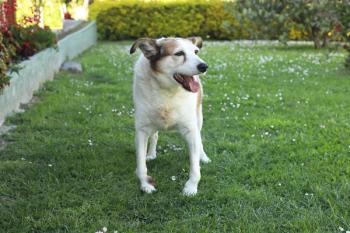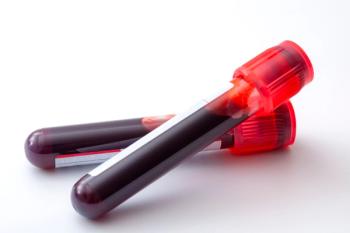
Improving veterinary visits for senior patients
Instead of teaching an old dog new tricks, try learning some yourself! Here are a few things you can do to improve veterinary visits for aging pets.
Amy Newfield's dog Meeko, who turns 15 years old this month. (Photo courtesy of Amy Newfield.)
Senior pets are amazing, and rarely get the credit they deserve. Compared to juvenile cats and dogs, most senior pets have an understanding of veterinary clinics. They tend to be more tolerant to procedures like catheters, blood draws and even hospitalization. To return the favor, here are some tips to help you better understand (and care for) senior patients.
Handling diminished senses
Sight
As dogs and cats age, their ability to see in the dark diminishes, making them more sensitive to light changes around them and causing them to frequently bump into walls. Older pets also experience diminished depth perception, and their eyes can lose the ability to process how fast objects are moving. Coming into a practice from the sunny outdoors can even cause problems. Take a moment when walking or carrying a senior patient from a light room to a darker space (i.e. the radiology room). If the pet puts on the breaks, don't try to force them in to the darker room. Instead, take time to let their eyes adjust.
Sound
Talking to pets is one of the primary ways we communicate with them, but old age shrinks pets' ability to hear. To combat this, make sure senior patients can always see you to prevent startling them. Getting in front of patients before picking them up may be the difference between a bite or a lick. If the pet is facing the back of the cage, move their blankets and let them know you're there before reaching in.
Taste
Loss of taste buds and changes in taste also come with old age. Diseases, especially those that are dental and renal in nature, can make food taste badly, causing the pet to eat very little. Next time you have an older patient that doesn't want to eat, try warming up their food. If that doesn't work, you may need to try multiple foods to find what their taste buds will tolerate.
Smell
Humans have approximately five million receptors in their nasal passages to process smell. Cats have around 80 million. Dogs top the charts at 300 million, which is why they rely on this sense the most. We don't know exactly what happens to their sense of smell as they age, but likely it also diminishes to some degree. Senior pets experiencing upper respiratory or airway issues may have lower appetites. Since the sense of smell directly correlates to taste, you may need to warm up the patient's food or provide more enticing meals.
Improving senior care
Behavior
Elderly dogs and cats can suffer from an Alzheimer's-like disease called canine cognitive dysfunction
Senior patients with CCD or experiencing senility may be more confused and disoriented in a hospital setting. Cats may forget to use the litter box or be unable to climb into it. In my experience, most senior cats urinate on themselves in a hospital setting. Making hideaway boxes for older felines or putting them in a quiet area can help reduce their levels of confusion or frustration. Using low access litter boxes can help with these bathroom issues.
Older dogs tend to vocalize or pace if they're disoriented. Sometimes older dogs can snap or become aggressive out of fear and disorientation. Talk to the dog using familiar words, have a scent object from the owner or use foods to help calm the patient.
Arthritis
Vocalization is rare when it comes to arthritis in pets. Older cats might cry when they are picked up and scruffing should be avoided. Tugging the back legs for blood samples from the medial saphenous vein could be painful and laying the cat on its side for a radiograph may elicit aggression.
Small dogs may try to bite when picked up out of cages or from floors. Older dogs may yelp when forced into a sit or down position. Rolling a vein on a front leg for a catheter could be painful for a pet with elbow arthritis. Allow the pet to stand and use less restraint if possible. Also, a nicer bed equals a happier, more comfortable pet that's more likely to sleep and therefore heal faster. Clinics should consider investing in foam or orthopedic beds for older patients.
Anesthesia
Senior dogs and cats can have postoperative cognitive dysfunction (POCD), causing them to be confused, agitated, aggressive or depressed when waking up from anesthesia. In 2008, Duke University released a study showing that human, geriatric adults can experience POCD signs for up to three months after being given anesthesia.1
The study sampled over a thousand adults with ages ranging from young to old. All participants were given memory tests before and after anesthesia. About 36% to 41% of participants experienced some form of POCD immediately following the procedure. All participants had fully recovered after three months, except those who were 60 years or older; 12.7% of the population 60 years old and higher still experienced POCD symptoms after three months.
A similar pattern likely occurs in veterinary geriatric patients. This would explain why when they recover from anesthesia some vocalize, pace, pant and appear disoriented. POCD would also explain why some dogs are depressed for months following anesthesia. Sometimes these patients need to be sedated or even put on a constant-rate-infusion of sedation until the anesthesia wears off. Getting these patients back home to their familiar environment or allowing owners to visit may help.
Senior pets are still just as loving as they were when they were puppies, and with a little extra kindness and consideration, we can still make them feel right at home.
Reference
1. Maze M, Cibelli M, Grocott HC. Taking the lead in research into postoperative cognitive dysfunction. Anesthesiology 2008;108(1):18-30.
Newsletter
From exam room tips to practice management insights, get trusted veterinary news delivered straight to your inbox—subscribe to dvm360.






